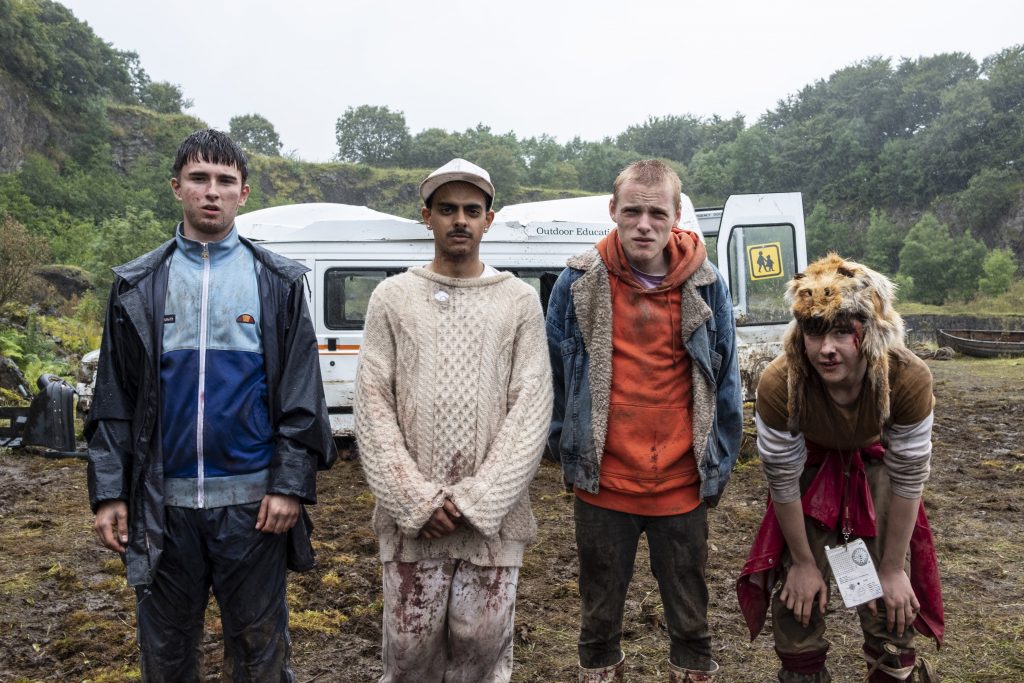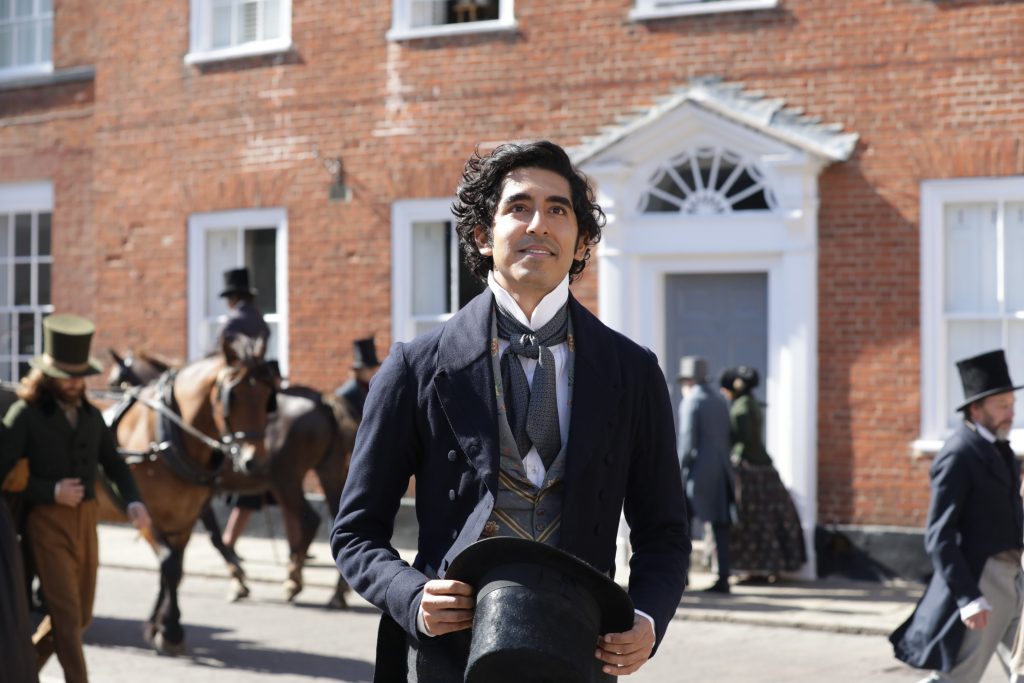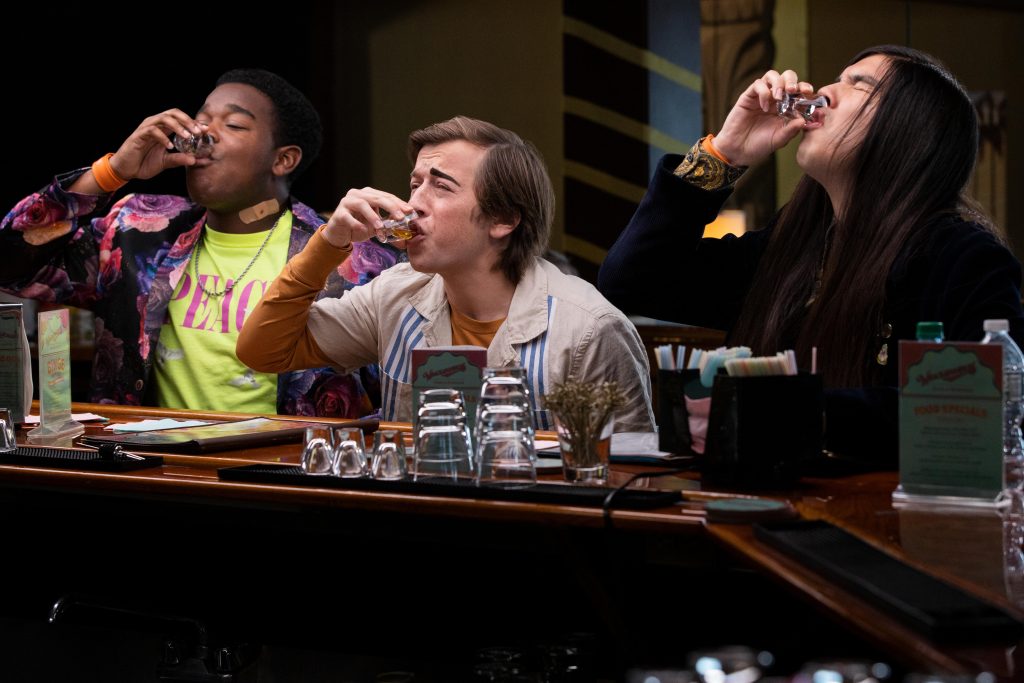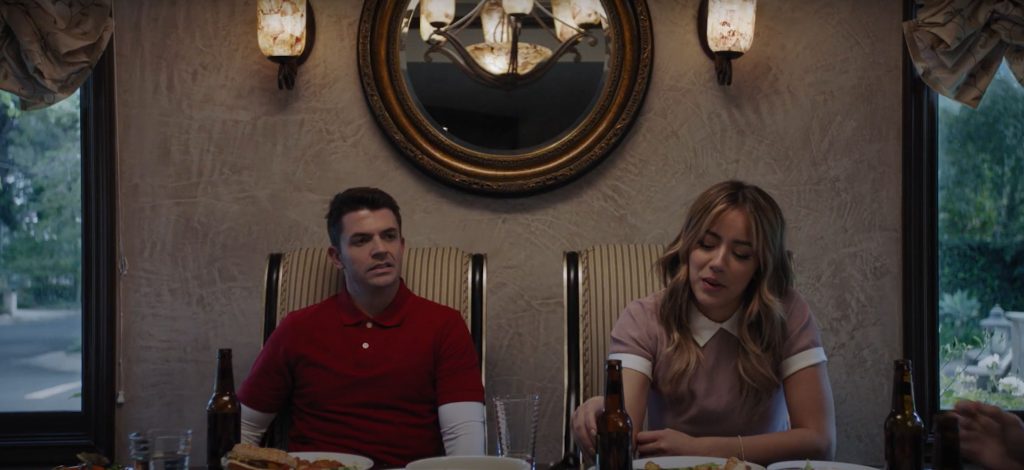September 25, 2020
by Carla Hay
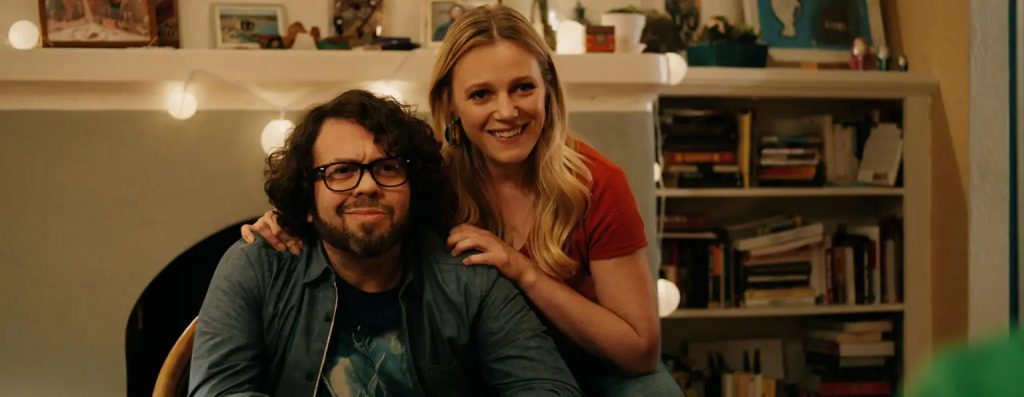
Directed by Robert Schwartzman
Culture Representation: Taking place in Los Angeles, the romantic comedy “The Argument” features a racially diverse cast (white, black and Asian) representing the middle-class.
Culture Clash: A playwright and his actress girlfriend, with the help of some of their friends and random strangers, recreate an argument that the couple had to determine who was correct in the argument.
Culture Audience: “The Argument” will primarily appeal to people who like over-the-top, fast-paced comedies with many unrealistic moments but enough wacky sensibilities to keep people watching to see how it all ends.
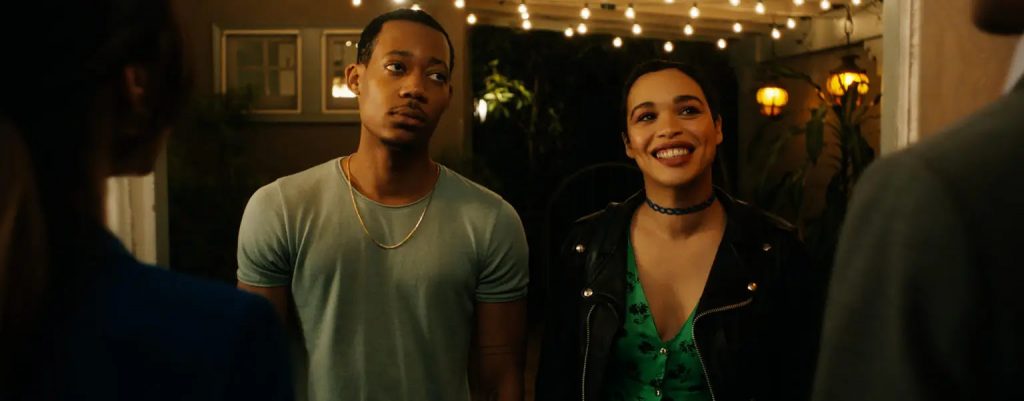
The absurdist romantic comedy “The Argument” will test the patience of many viewers who are looking for a more conventional way that love and relationships are depicted in the story’s plot. The movie suffers when the “repeat loop” part of the story is focused only on the six main characters. But “The Argument” is at its best during “casting session/script reading” scenes in the last third of the movie, when random strangers are introduced to the main characters and turn the movie into many laugh-out-loud moments that are sly commentaries about ego posturing and stereotypes in relationships.
Directed with a madcap pace by Robert Schwartzman and written by Zac Stanford, “The Argument” (which takes place in Los Angeles) centers on an artistic couple named Jack (played by Dan Fogler) and Lisa (played by Emma Bell), who live together in a modest Hollywood home. Jack is a playwright/screenwriter, and Lisa is an actress. They’ve been dating each other for three years.
It’s revealed later in the movie that Jack and Lisa met through a fairly obscure horror movie that Jack wrote called “The Dead Doth Trod the Hills at Night.” Lisa had a small background role as a zombie in the movie. Jack’s most recent project is an independent play called “Wolfgang,” which has Lisa as the leading female role of Constanze, the wife of Wolfgang Amadeus Mozart. The play has a modern comedic tone to it, and it’s recently ended its run at a small theater. Based on the number of people in the audience for the last show, the play’s attendance was fairly good, but not great.
The biggest problem that Jack had with the play is how Lisa and the vain actor who was cast as Mozart seemed just a little too flirtatious with each on stage and off stage. The actor’s name is Paul (played by Tyler Christopher Williams), and Jack is jealous because Paul is younger and better-looking than Jack is. Jack’s suspicion that Lisa and Paul are sexually attracted to each other is a nagging thought that he’s kept to himself, but it later explodes in messy and uncomfortable ways in other parts of the story.
Now that the play is over, Jack thinks he and Lisa won’t have to deal with Paul anymore. After the last night of “Wolfgang,” Jack plans to have a small cocktail party at his and Lisa’s home. Jack has invited his and Lisa’s two closest friends—married couple Brett and Sarah—to celebrate.
Brett (played by Danny Pudi) is Jack’s eager-to-please literary agent. Sarah (played by Maggie Q) is an entertainment lawyer with an icy demeanor and a photographic memory. Jack has another intention for the party, which is pretty obvious in the message that he sends to Brett and Sarah: Jack is going to propose to Lisa.
When Sarah and Brett show up for the party, Brett is happy to be there, but Sarah seems very uninterested. She explains that she has to get up early in the morning because she has an important contract negotiation meeting the next day. Sarah was the attorney who negotiated the overseas rights to “The Dead Doth Trod the Hills at Night,” but she’s frustrated that Jack hasn’t been a lucrative client for Brett.
Sarah blames Jack and Brett for Jack not being able to get much work as a writer. None of Jack’s screenplays has sold since “The Dead Doth Trod the Hills at Night.” Sarah thinks that Jack isn’t very talented and that Brett isn’t a great agent. By contrast, Brett is in awe of Jack and isn’t ready to give up on him so easily. At one point during the party, Brett gushes in Jack’s presence that Jack “isn’t just a great writer … he’s a genius.”
The party is interrupted by two guests whom Jack did not expect: Paul and his ditzy Australian girlfriend Trina (played by Cleopatra Coleman), who soon finds out that she’s not the only one who’s suspected that there’s been sexual tension between Paul and Lisa. Jack is very surprised to see Paul and Trina at his door, but he lets them in because he doesn’t want to be rude and because he finds out that Lisa invited them.
Jack takes Lisa aside for a private conversation in their dining room, and they briefly argue about Paul being at the party. (Observant viewers might notice that the dining room walls in the movie have posters of Schwartzman’s first two movies that he directed: 2016’s “Dreamland” and 2018’s “The Unicorn.”) Lisa insists that she told Jack in advance that Paul would be there. Jack is equally insistent that Lisa never told him, because if she had, he would’ve remembered. They reach a stalemate but agree that Paul might as well stay at the party.
As the party goes on, Jack gets more and more irritated because Lisa and Paul keep re-enacting flirtatious and sexually suggestive scenes from the play in front of everyone. Lisa and Paul think it’s hilarious, but Jack obviously doesn’t. Meanwhile, Sarah looks very bored, Brett tries to keep things friendly with everyone, and Trina starts drinking enough alcohol to get tipsy and overly talkative. Trina mentions that she and Paul (who has a day job as a fitness instructor) got together as a couple because she signed up for one of his fitness classes, in the hopes that he would notice her and want to date her.
It turns out that Trina is a big fan of “The Dead Doth Trod the Hills at Night” and she actually remembers Lisa’s role in the film. Trina gushes like a fangirl about the movie, which endears her to Jack and Lisa. However, Paul continues to get on Jack’s nerves. When Jack serves a charcuterie board at the party, Paul says he can’t eat almost anything that’s served at the party because he’s a vegan and he’s on a strict diet for a fitness commercial that he’s about to film. Jack is also baking an apple pie, which he plans to serve as dessert.
As the night wears on, Paul and Trina grow more uncomfortable with Lisa and Paul’s flirtatious shenanigans in front of everyone. Jack starts rambling about Antonio Salieri, Mozart’s rival who was famously jealous of Mozart’s talent, fame and accolades. Lisa makes a seemingly innocuous remark that Jack “isn’t really comfortable with the word ‘genius.'”
Jack interprets the comment to mean that Lisa doesn’t think that Jack isn’t very smart, so he shouts at her, “That’s not funny!” The argument between Jack and Lisa escalates to the point when Jack ends up taking the apple pie out of the oven and throws it on the ground. And the party abruptly ends.
The next morning, Jack and Lisa are in bed and they continue to argue about what happened the previous night. “I wish I could redo the whole night so you could see how wrong you are!” Lisa shouts. Jack says the same thing to her. And then they have an “aha” moment and decide to recreate the party and have the guests decide if Jack or Lisa was the one was in the wrong.
The middle section of “The Argument” is a little hard to take because of the shrill and annoying ways that the party is recreated. Because the movie makes it clear from the beginning that it’s an absurdist comedy, viewers will have to suspend their disbelief that Jack and Lisa’s party guests have nothing better to do with their time than go through with these ridiculous re-enactments. Trina shows up hung over, and she reluctantly agrees to get drunk again for every re-enactment. Jack even goes as far as preparing the same food over and over again every time they do a re-enactment.
Of course, the re-enactments don’t go smoothly because no one (except for Sarah, who has a photographic memory) can remember exactly how they acted and what they said the first time the party happened. Because everyone goes “off-script” at one point or another, it leads to more tension and arguments.
Sarah’s jaded attitude becomes even more apparent when Trina says being an entertainment lawyer must be glamorous, and Sarah’s deadpan response is, “It’s just a job. I don’t even like movies.” Eventually, Sarah gets fed up with the re-enactments and leaves.
“The Argument” finally starts to improve in the last third of the movie, when the party guests find out that Jack has put an ad on Craiglist to get actors (whose character names are not revealed in the movie) to come to his and Lisa’s home and to portray the party guests during these re-enactments, with the original party guests (except for Sarah) in attendance. Jack has even written a script, which is heavily skewed with his biased perspective.
The actors who answered the Craigslist ad have been told that it’s supposed to be an audition/read-through, with Jack being the one to decide who will play which role. Therefore, it comes as no surprise that Jack casts the best-looking “hunky” guy of the auditionees to portray Jack, who’s written as the hero of the story. (The role of Actor Jack is played by Mark Ryder.)
Actor Trina is an ultra-liberal, ultra-politically correct African American activist (played by Marielle Scott), who over-exaggerates and bungles the real Trina’s Australian accent, which offends Trina. Actor Lisa (played by Charlotte McKinney) is a big-breasted blonde who has her bikini photos on hand, while Lisa is offended that Jack wants a “bimbo” to portray her.
Actor Brett (played by Karan Brar) pretty much agrees with everyone, while the real Brett is offended that he’s being portrayed as a pushover without a mind of his own. Meanwhile, since Sarah isn’t there, Jack decides that Actor Brett can use a sock puppet to portray Sarah. Actor Paul (played by Nathan Stewart-Jarrett) is a loudmouth wannabe rapper (who wears gold chains), which offends the real Paul, who’s nothing like this walking racial stereotype, but Actor Paul ends up upstaging everyone in the room.
What Jack has written in the script is read aloud by the auditionees to hilarious results, because it reveals Jack’s perceptions and opinions of everyone at the party. If this “script reading” part of the plot had been put earlier in the movie, the quality of “The Argument” would have been much higher.
Fogler and Coleman handle the slapstick scenes fairly well, while Williams makes great use of facial expressions. All of the actors playing the “auditionees” are very good and bring much-needed spark to the movie. Stewart-Jarrett is the movie’s biggest scene stealer, since he’s easily the funniest part of this movie, whose comedic scenes are hit and miss.
Fogler, Bell, Pudi, Q, Williams and Coleman are talented, but the way the characters are written tend to become one-note caricatures by the middle of the film. Having other actors come into the story to portray those characters is a clever send-up that works well. The discomfort that the real Jack, Lisa, Brett, Paul and Trina feel at seeing how other people portray them is actually funny, whereas the original argument between Lisa and Jack wasn’t that funny. There’s an almost British sensibility to this “script within a script” parody.
Because director Schwartzman moves the pace of “The Argument” along fairly quickly, it’s easier to take the cringeworthy aspects of the movie. For example, some of the people in “The Argument” over-act—and not in a good way that was intended by the screenplay. And there’s some physical comedy that could have been choreographed better.
The Jack character can be very grating with his “control freak” insecurities and insistence on always being right. Lisa is also irritating with her tendency to be self-absorbed and not very empathetic to other people’s feelings. Some viewers might find it hard to root for this couple.
“The Argument” can best be appreciated when the main characters (and their flaws) are put up to a proverbial mirror and they see how complete strangers (who are wannabe actors) perceive and act out their personalities. Sarah eventually finds out that Jack cast her as a sock puppet, and so her reaction (which isn’t as funny as it could’ve been) is also part of the movie’s plot. If people are willing to keep watching “The Argument” until the “script reading” scenes, it will be worth the wait, because those scenes redeem what could have been a completely annoying movie.
Gravitas Ventures released “The Argument” on digital and VOD on September 4, 2020.









